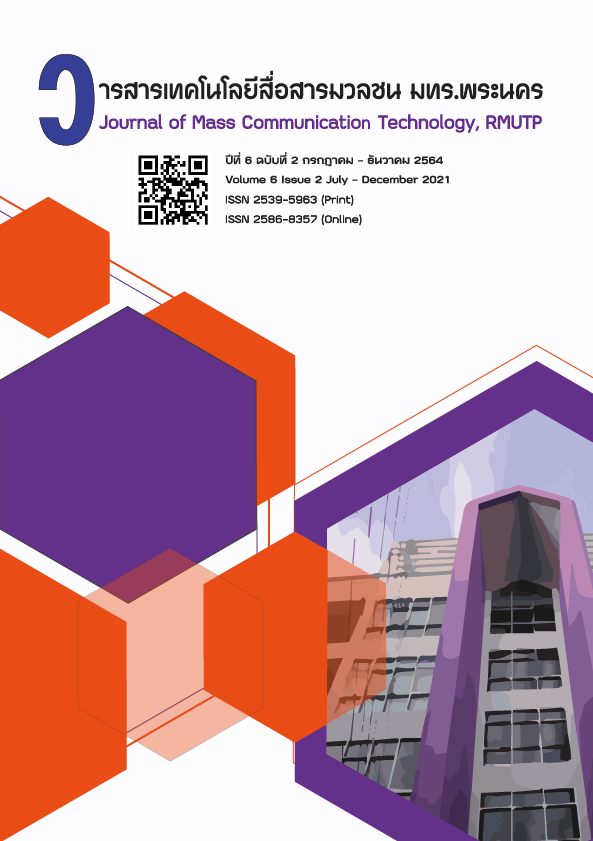The Development of Multisensory Virtual Reality Game for Stroke Patients
Keywords:
Multisensory, Virtual Reality, Design, Occupational Therapy, Stroke PatientsAbstract
The objectives of this research were to 1) study the principles of therapy of cerebrovascular patients with virtual reality technology, 2) develop a therapeutic model for cerebrovascular patients with virtual reality multi-sensory games, and 3) study the results of the use of a multi-sensory model with virtual reality technology for cerebrovascular patients. By using qualitative research methods, this study was investigated for the multiple sensory design data associated with occupational therapy for cerebrovascular patients. Consolidating data from non-participant observations, talking to the caregiver, occupational therapist, research tools expert review, and in-depth Interview. The results were analyzed by five virtual reality design specialists, 2 occupational therapists, 10 caregivers or close relatives, and 10 cerebrovascular patients, using the result collection tool, including structured interviews. The interview responses are carefully controlled. The research found that 1) The design of the environment and activities that are close to the real-life, stimulates the patient to have the strength to move the muscles in different parts by themselves. 2) The game had various functions, it was no need to use all parts of the game, patients could select suitable functions for muscle therapy. 3) Development of the patients when using multisensory virtual reality from week 1 to week 8 were improved, respectively. By using the multisensory virtual reality game in conjunction with the regular occupational therapy courses that the patient had to do. The occupational therapists and caregivers agreed that patients had better conditions than conventional occupational therapy used. 4) The use of multisensory virtual reality games must be supervised by supervisor who could help the patients all the time. In some games, the patient might exert excessive exertion or move away from the chair that could cause an accident. 5) When using multisensory virtual reality in the real environment, the sound level and privacy should be considered not to cause patients’ stress.
References
คณะทำงานจัดทำรายงานประจำปีของกองโรคไม่ติดต่อ, ป.พ.ศ. (2562). รายงานประจำ ปี 2562 กองโรคไม่ติดต่อ กรมควบคุมโรค.
จักรกริช กล้าผจญ, นพพล ชูศรี, ปฏิสนธิ์ ปาลี, ศุภรา กรุดพันธ์ และศิรประภา วัฒนากุล. (2563). ระบบเกมโลกเสมือนจริงสำหรับผู้ป่วยโรคหลอดเลือดสมอง. สถาบันวิจัยระบบสาธารณสุข. สืบค้นจาก https://kb.hsri.or.th/dspace/handle/11228/5281?show=full.
ทวีศักดิ์ สิริรัตน์เรขา และสมจิตร ไกรศรี. (2553). โปรแกรมศิลปกรรมบำบัด สถาบันราชานุกูล. วารสารราชานุกูล, 25(3) กันยายน-ธันวาคม, 22-31.
อรรถเกียรติ กาญจนพิบูลวงศ์, สุธิดา แก้วทา. (2563). รายงานสถานการณ์โรค NCDs เบาหวาน ความดันโลหิตสูง และปัจจัยเสี่ยงที่เกี่ยวข้อง พ.ศ. 2562. กรุงเทพมหานคร: อักษรกราฟิกแอนด์ดีไซน์.
Bertalan Mesko. (2020). Virtual Reality Can Help Women Get Through Childbirth With Less Pain. The Medical Futurist. Retrieved from https://medicalfuturist.com/virtual-reality-help-women-get-through-childbirth-with-less-pain/.
Bystrom, K.-E., Barfield, W., & M. Hendrix, C. (1999). A Conceptual Model of the Sense of Presence in Virtual Environments (Vol. 8).
Chagué, S., & Charbonnier, C. (2016). Real Virtuality: A Multi-User Immersive Platform Connecting Real and Virtual Worlds.
Cieślik, B., Mazurek, J., Rutkowski, S., Kiper, P., Turolla, A., & Szczepańska-Gieracha, J. (2020). Virtual reality in psychiatric disorders: A systematic review of reviews. Complementary Therapies in Medicine, 52, 102480. doi:https://doi.org/10.1016/j.ctim.2020.102480.
Covarrubias, M., Bordegoni, M., Rosini, M., Guanziroli, E., Cugini, U., & Molteni, F. (2015). VR system for rehabilitation based on hand gestural and olfactory interaction. Paper presented at the Proceedings of the 21st ACM Symposium on Virtual Reality Software and Technology, Beijing, China.
G. Witmer, B., & J. Singer, M. (1998). Measuring Presence in Virtual Environments: A Presence Questionnaire (Vol. 7).
Garcia, L. M., Birckhead, B. J., Krishnamurthy, P., Sackman, J., Mackey, I. G., Louis, R. G., . . . Darnall, B. D. (2021). An 8-Week Self-Administered At-Home Behavioral Skills-Based Virtual Reality Program for Chronic Low Back Pain: Double-Blind, Randomized, Placebo-Controlled Trial Conducted During COVID-19. J Med Internet Res, 23(2), e26292. doi:10.2196/26292.
Gutierrez, M., Vexo, F., Thalmann, Daniel. (2008). Stepping into Virtual Reality. Switzerland: Springer Nature.
Guttentag, D. A. (2010). Virtual reality: Applications and implications for tourism. Tourism Management, 31(5), 637-651. doi:https://doi.org/10.1016/j.tourman.2009.07.003.
Hajesmaeel-Gohari, S., Sarpourian, F., & Shafiei, E. (2021). Virtual reality applications to assist pregnant women: a scoping review. BMC Pregnancy and Childbirth, 21(1), 249. doi:10.1186/s12884-021-03725-5.
Kate Merrick. (2021). Global Virtual Reality (VR) In Healthcare Industry. Retrieved from https://www.reportlinker.com/p05336795/Global-Virtual-Reality-VR-in-Healthcare-Industry.html?utm_source=GNW:.
Marie Dealessandri. (2020, 2nd April 2020). The best practices and design principles of VR development. Retrieved from https://www.gamesindustry.biz/articles/2020-04-01-the-best-practices-and-design-principles-of-vr-development.
Marion Martin. (2009). Boredom as an Important Area of Inquiry for Occupational Therapists. British Journal of Occupational Therapy, 72(1), 40-42.
Martin A. Conway. (2001). Sensory-perceptual episodic memory and its context : autobiographical memory. The Royal Society, 1375-1384.
Mazuryk, T., & Gervautz, M. (1999). Virtual Reality - History, Applications, Technology and Future. Retrieved from https://www.researchgate.net/publication/2617390_Virtual_Reality_-_History_Applications_Technology_and_Future.
Misha Sra, a. C. S. (2015). MetaSpace II: Object and Full-body Tracking for Interaction and Navigation in Social VR. arXiv.
Spiegel B, F. G., Lopez M, Dupuy T, Noah B, Howard A, et al. (2019). Virtual reality for management of pain in hospitalized patients: A randomized comparative effectiveness trial. PLoS ONE, 14(8). doi:https://doi.org/10.1371/journal.pone.0219115.
Susan Brandis. (2020). Why we got bored in lockdown–an occupational perspective. Retrieved from https://bond.edu.au/nz/blog/why-we-got-bored-lockdown-occupational-perspective.
World Stroke Organization. (2019). World Stroke Organization (WSO) Annual Report 2019. Retrieved from https://www.world-stroke.org/assets/downloads/WSO_2019_Annual_Report_online.pdf.

Downloads
Published
How to Cite
Issue
Section
License
Copyright (c) 2021 ่่๋๋Journal of Mass Communication Technology, RMUTP

This work is licensed under a Creative Commons Attribution-NonCommercial-NoDerivatives 4.0 International License.
Copyright (c) Journal of Mass Communicaiton Technology, RMUTP
Journal of Journal of Mass Communicaiton Technology, RMUTP is licensed under a Creative Commons Attribution-NonCommercial-NoDerivatives 4.0 International License. (CC BY-Nc-ND 4.0) licence, unless otherwise stated. Please read our Pollicies page for more information on Open Access, copyright and permissions.



